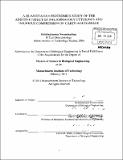| dc.contributor.advisor | Alan J. Grodzinsky. | en_US |
| dc.contributor.author | Swaminathan, Krishnakumar | en_US |
| dc.contributor.other | Massachusetts Institute of Technology. Dept. of Biological Engineering. | en_US |
| dc.date.accessioned | 2011-11-18T21:01:20Z | |
| dc.date.available | 2011-11-18T21:01:20Z | |
| dc.date.copyright | 2011 | en_US |
| dc.date.issued | 2011 | en_US |
| dc.identifier.uri | http://hdl.handle.net/1721.1/67209 | |
| dc.description | Thesis (S.M.)--Massachusetts Institute of Technology, Dept. of Biological Engineering, 2011. | en_US |
| dc.description | Cataloged from PDF version of thesis. | en_US |
| dc.description | Includes bibliographical references (p. 103-123). | en_US |
| dc.description.abstract | Objectives: 1) To perform a quantitative comparison of proteins released to media on combination with cytokine (IL-1[beta[ or TNF-[alpha]) and Injury as compared to either treatment alone, and to thus identify proteins which may be responsible for the synergism seen between cytokine and injury in causing catabolism of cartilage in vitro. 2) To identify proteins which contribute most to some commonly observed phenotypes on treatment of cartilage with cytokine or injury or both. Methods : Cartilage explants from calves were treated with (i)IL-1 (10 ng/ml), (ii)TNF[alpha] (100 ng/ml), (iii)Injurious compression (50% strain at 100%/sec) and IL-1[beta] (10 ng/ml) or (iv)Injurious compression (50% strain at 100%/sec) and TNF-[alpha](10 ng/ml), cultured for 5 days post treatment, and the pooled media collected, labeled with one of four iTRAQ labels and subjected to nano-2D-LC/MS/MS on a quadrupole time of flight instrument. Peptides were identified and quantified using Protein PilotTM, and MATLAB scripts used to obtain protein ratios. These results were analyzed using different statistical techniques. Data from two iTRAQ experiments were combined to generate data for all possible injury and cytokine treatment conditions, and proteins on which injury and cytokines acted synergistically identified. PLSR analysis was performed using Unscrambler®X software with the combined data set to determine which proteins are most relevant to some observed phenotypes. The phenotypes chosen were sGAG released to media in 5 days post treatment, proline and sulfate incorporation rates on day 6 post treatment, and nitrite accumulation in media in 5 days post treatment Results and Discussion: TNF-[alpha]+injury and IL-[beta] +injury treatment conditions show a very high correlation with each other. Most cytosolic, ER lumen and nuclear protein levels are highly elevated with both cytokine+injury conditions, while ECM proteins are either highly down regulated or marginally elevated. Many collagen telopeptides are down regulated, possibly indicating reduced anabolism. However, attempts at repair exist, as shown by increased levels of TGF-[beta] and activin A, and reduced levels of LTBP1. Also, biglycan and lumican, SLRPs known to be involved in early development are significantly increased, possibly indicating repair attempts. Other SLRPs such as PRELP and chondroadherin are also highly elevated, with one or both injury+cytokine treatments. While MMPs are mildly down regulated or remain the same, ADAMTS1 increases with TNF-a+injury, indicating increased catabolism. Among ECM structural proteins, COMP shows high down regulation with TNF-[alpha]+injury, possibly due to reduced synthesis. Proenkephalin, a signaling molecule possibly involved in tissue/repair and apoptosis, AIMPI, a multifunctional proapoptotic, inflammatory and pro-repair cytokine and Annexin A5, a protein indicating mineralization and apoptosis are all highly elevated with cytokine+injury indicating heightened apoptosis and/or repair. When results of two 4-plex iTRAQ experiments are combined to obtain data for all possible combinations of injury and cytokine, we again find a very high correlation between TNF-a+injury and IL-1 +injury (-95%), slightly higher than the correlation between TNF-[alpha] alone and IL-[beta] alone (-90%), and much higher than the correlation of either cytokine+injury condition with cytokine alone (-70%) or injury alone (-75%). | en_US |
| dc.description.abstract | (cont.) This shows that IL-1[beta] and TNF-[alpha] in combination with injury act through very similar pathways in chondrocytes to produce their effect on cartilage tissue. TNF-a and injury were seen to act synergistically in a positive fashion on aggrecan, CILP-2, COL6A3 and histone H4, and in a negative fashion on SPARC and IGFBP7, suggesting that these proteins may be involved in causing synergism between injury and cytokine in releasing sGAG to the media. A PLSR analysis shows that SPARC and IGFBP7 project close to proline and sulfate incorporation, and far away from sGAG, indicating that SPARC and IGFBP7 may be proteins involved in anabolism. The highest phenotype-protein positive correlations obtained using PLSR are sGAG with Perlecan, SAA3, Complement factor B, CILP-2 and pleiotropin, indicating that all these 5 proteins are associated strongly with catabolism and can serve as markers of catabolism. The correlation of inflammatory proteins SAA3 and complement factor B with sGAG indicates the role of inflammation with catabolism. Conclusion: The combination of injury and cytokine affects tissue differently at a molecular level as compared to either chemical or mechanical stresses alone. Increased catabolism and increased attempts at tissue repair are observed due to a combination of injury and cytokine, and a combination of injury and cytokine may thus serve as a useful model to study OA in vitro. | en_US |
| dc.description.statementofresponsibility | by Krishnakumar Swaminathan. | en_US |
| dc.format.extent | 139 p. | en_US |
| dc.language.iso | eng | en_US |
| dc.publisher | Massachusetts Institute of Technology | en_US |
| dc.rights | MIT theses may be protected by copyright. Please reuse MIT thesis content according to the MIT Libraries Permissions Policy, which is available through the URL provided. | en_US |
| dc.rights.uri | http://dspace.mit.edu/handle/1721.1/7582 | en_US |
| dc.subject | Biological Engineering. | en_US |
| dc.title | A quantitative proteomics study of the additive effect of inflammatory cytokines and injurious compression on cartilage damage | en_US |
| dc.type | Thesis | en_US |
| dc.description.degree | S.M. | en_US |
| dc.contributor.department | Massachusetts Institute of Technology. Department of Biological Engineering | |
| dc.identifier.oclc | 759079194 | en_US |
